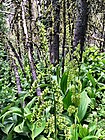Note: This is a project under development. The articles on this wiki are just being initiated and broadly incomplete. You can Help creating new pages.
Veratrum viride - Indian hellebore
All parts of the plant are highly poisonous. After the plant dies down in the autumn and has been frosted, the toxins decrease and the plant becomes harmless to animals.
Contents
- 1 Uses
- 2 Parts Used
- 3 Chemical Composition
- 4 Common names
- 5 Properties
- 6 Habit
- 7 Identification
- 8 List of Ayurvedic medicine in which the herb is used
- 9 Where to get the saplings
- 10 Mode of Propagation
- 11 How to plant/cultivate
- 12 Commonly seen growing in areas
- 13 Photo Gallery
- 14 References
- 15 External Links
Uses
Wounds, High blood pressure, Pneumonia, Peritonitis, Chronic coughs, Constipation, Stomach pain.[1]
Parts Used
Chemical Composition
It contains The veratrum alkaloids, which are chemically similar to steroids, include protoveratrine, veratridine etc.[2]
Common names
| Language | Common name |
|---|---|
| Kannada | |
| Hindi | |
| Malayalam | |
| Tamil | |
| Telugu | |
| Marathi | |
| Gujarathi | |
| Punjabi | |
| Kashmiri | |
| Sanskrit | |
| English |
Properties
Reference: Dravya - Substance, Rasa - Taste, Guna - Qualities, Veerya - Potency, Vipaka - Post-digesion effect, Karma - Pharmacological activity, Prabhava - Therepeutics.
Dravya
Rasa
Guna
Veerya
Vipaka
Karma
Prabhava
Habit
Identification
Leaf
| Kind | Shape | Feature |
|---|---|---|
Flower
| Type | Size | Color and composition | Stamen | More information |
|---|---|---|---|---|
| {{{5}}} |
Fruit
| Type | Size | Mass | Appearance | Seeds | More information |
|---|---|---|---|---|---|
Other features
List of Ayurvedic medicine in which the herb is used
Where to get the saplings
Mode of Propagation
How to plant/cultivate
Requires a deep fertile moisture retentive humus-rich soil. Succeeds in full sun if the soil does not dry out but prefers a position in semi-shade.[4]
Commonly seen growing in areas
Swamps, On Moist meadows, On low ground.
Photo Gallery
References
- ↑ Indian Medicinal Plants by C.P.Khare
- ↑ Chemical constituents
- ↑ [Morphology]
- ↑ Cultivation
External Links
- Ayurvedic Herbs known to be helpful to treat Wounds
- Ayurvedic Herbs known to be helpful to treat High blood pressure
- Ayurvedic Herbs known to be helpful to treat Pneumonia
- Ayurvedic Herbs known to be helpful to treat Peritonitis
- Ayurvedic Herbs known to be helpful to treat Chronic coughs
- Ayurvedic Herbs known to be helpful to treat Constipation
- Ayurvedic Herbs known to be helpful to treat Stomach pain
- Herbs with Roots used in medicine
- Habit - Perennial
- Index of Plants which can be propagated by Root cuttings
- Herbs that are commonly seen in the region of Swamps
- Herbs that are commonly seen in the region of On Moist meadows
- Herbs that are commonly seen in the region of On low ground
- Herbs





